Nikon S3 Year 2000 Millennium Model
- Nikon S3 Year 2000 Millennium Model - A reproduction of the vintage rangefinder camera Nikon S3
- Birth of S3 Reproduction Project
- Procurement of Component Elements - A key factor for the reproduction
- Assembly through finished product
- Major Specifications
- Differences between the S3 Year 2000 Millennium Model and the original S3
Nikon S3 Year 2000 Millennium Model - A reproduction of the vintage rangefinder camera Nikon S3
Nikon S3 Year 2000 Millennium (Y2K) model (hereinafter referred to as S3 Replica model) is a near duplicate of the rangefinder camera Nikon S3 released in March 1958. It was produced in limited quantity to commemorate the year 2000 millennium. The S3 Y2K was made identical as possible to the original Nikon S3 except for very minor details to accommodate the present camera operating practices, including the change in the exposure indication from "20" to "24," and the film sensitivity indication calibrated in "ISO" instead of "ASA."
Nikon started their 35 mm rangefinder camera product line with Nikon I launched in 1948, which evolved into M and S later, and the rangefinder series was valued highly as a line of main cameras until the single-lens reflex (SLR) cameras became widespread. The S series was the precursor of Nikon F and was highly regarded as a classic camera, and there was a growing call for its revival from many enthusiasts.
Nikon S3 was a relatively later model in the S series, featuring a rangefinder with the world's first life-size 1:1 viewfinder for 35mm focal length lens. The Nikon S3 Y2K precisely reproduced not only the 35mm life-size viewfinder but also the focal length adjusting gear unit arranged in the upper right of the body, and the quiet and soft shutter releasing sound called “whispering shutter” which in those days was achieved by the cloth focal-plane shutter curtains.
The S3 Replica model was produced based on orders, and the orders were accepted from April 6, 2000 to June 30, 2000. It was first shipped in October 2000 and approx. 8,000 units were sold. The standard equipment Nikkor S 50 mm f/1.4 lens was a reproduction of the lens incorporated in the Olympic version, known as the all-black chrome-finish “later series” type. It was a multi-coated lens just like the currently available Nikkor lenses to ensure a higher degree of color reproducibility.
In June 2002, Nikon S3 LIMITED EDITION BLACK was introduced in a limited quantity of 2,000 by redesigning the S3 Replica model with a black chrome finish.
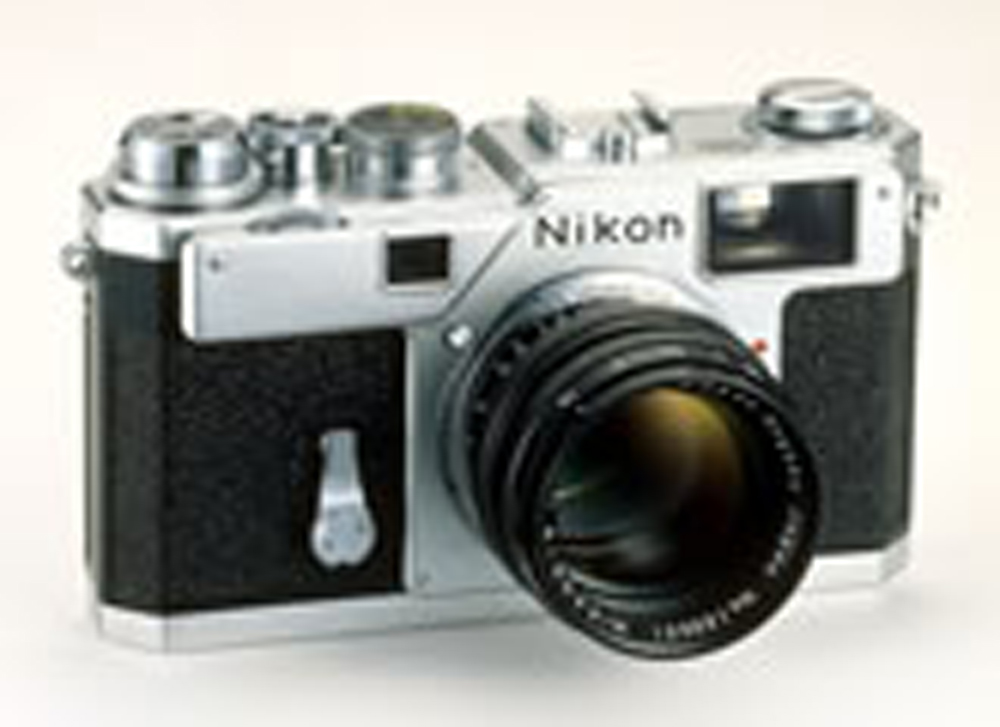
Product name : Nikon S3 Year 2000 Millennium Model
with Nikkor-S 50 mm f/1.4, lens cap, and lens hood
Suggested retail price : 480,000 yen (504,000 yen including tax)
Order accepting period : April 6, 2000 to June 30, 2000
Start of sales : October 2000
Number of units produced : Approx. 8,000
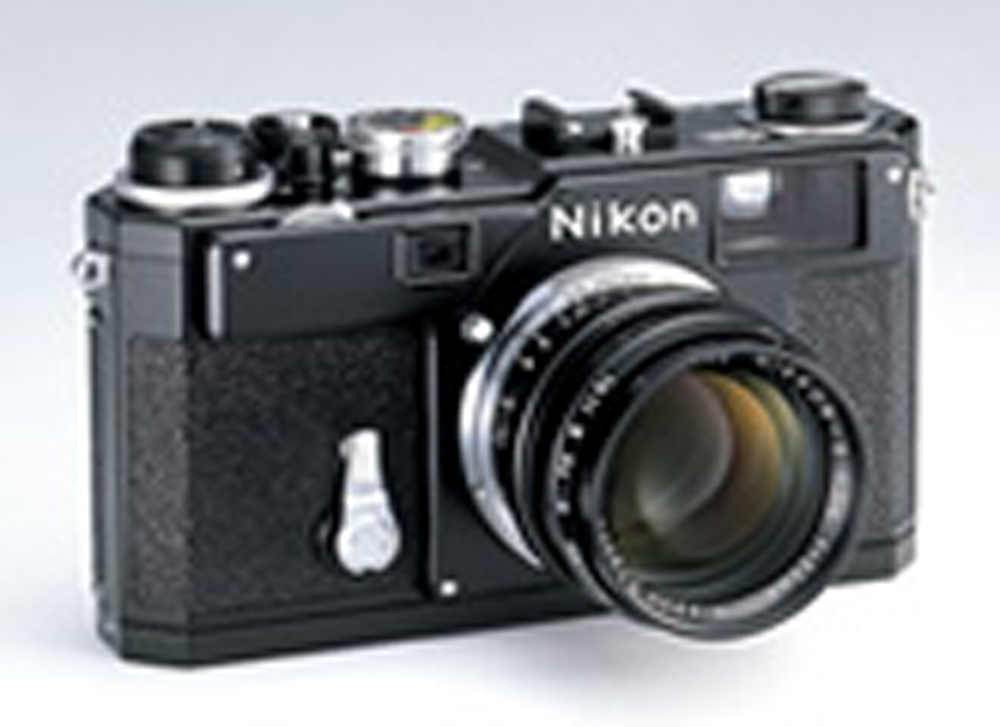
Product name : Nikon S3 LIMITED EDITION BLACK
with Nikkor-S 50 mm f/1.4, lens cap, lens hood, and camera case
Suggested retail price : 530,000 yen (556,500 yen including tax)
Start of sales : June 2002
Number of units produced : 2,000
Birth of S3 Reproduction Project
Calls for reproduction of rangefinder cameras
A revival of the former elaborate camera had been much anticipated within the Nikon group since the early 1990s. The most enthusiastic in favor of the revival in the Nikon group was Mito Nikon, which was then responsible for the production of F4, F3, and New FM2. Mito Nikon was a production plant primarily involved in manually operated cameras, and in the past it had manufactured the Nikomat series. The FM3A, whose sale was discontinued in January 2006, was also manufactured there. In the spring of 1994, driven by the surge of enthusiasm for Leica and other classic cameras, Mito Nikon initiated a new project to reproduce a Nikon's rangefinder camera which had once enjoyed great popularity for its outstanding performance.
The S3 was selected as a target for reproduction because at that time it was a relatively recent model in the S series, and also because it featured a simple mechanism and thus it was expected that it would be easier to reproduce from the technical aspect. However, it was a coupled rangefinder camera introduced to the market over 40 years ago, therefore there was some apprehension about whether the reproduction project would be feasible and a reproduction model could be actually realized.
Mito Nikon got the design drawings for S3 from Nikon and started a close study for the reproduction. It was soon discovered that a considerable upfront investment would be needed for the reproduction of the S series. That was an obstacle from a business standpoint. In addition, there was an economic decline in the next year 1995, and so the reproduction of S3 was aborted.
Initiation of the project 4 years after planning
As mentioned above, the S3 reproduction project was abandoned; however, in 1998, 3 years later, Mito Nikon was approached by Nikon Photo Products Inc. (present Nikon Imaging Japan Inc.), a sales company for Nikon's image-related products, about the reproduction of S3. That company insisted that coupled rangefinder cameras were very attractive products and that they wanted to express their appreciation to Nikon product lovers.
Mito Nikon, which had been incubating the plans for the reproduction of S3, and Nikon Photo Products Inc., which judged that the reproduction of coupled rangefinder camera would be a business opportunity, agreed with each other. The sales price was once estimated to be considerably high in the original study, though it was substantially reduced after reviewing the individual component parts and improving the manufacturing processes. Furthermore, Tochigi Nikon was relied upon to cooperate in the manufacturing of the lenses.
In November 1998, when a system for the implementation of the project was nearly established, four companies, Nikon, Mito Nikon, Tochigi Nikon and Nikon Photo Products Inc., had joint discussions and decided to start the project for the reproduction of S3. In December 1998, the S team was formed to implement the project, and then the project got into full swing.
Procurement of Component Elements - A key factor for the reproduction
Attention paid to faithfully reproduce even a single machine screw
The project was formally initiated, although it ran up against various barriers as the reproduction advanced. The reproduction of S3 Replica model involved three main processes: checking the original design drawings, making available the component elements, and training for assembly. Mito Nikon started the project with the acquisition of design drawings and the purchase of vintage S3 cameras from a used camera shop for reverse-engineering.
Mito Nikon made every effort to achieve as faithful a reproduction as possible. Its fastidiousness about faithful reproduction was overwhelming. In order to make the parts identical to those in the original S3, the production facilities, from press dies to die-casting dies, were all newly designed. Special attention was paid, one could say to the point of obsession, to the camera's external appearance, the shape of the machine screws for the outer casing and other parts, the texture of the matte-finish upper cover surfaces, the paint color and gloss, the etching line thickness and depth, the color of the letters on the shutter speed dial, and the grain of the artificial leather. Fortunately, for the grain of the artificial leather, the workmanship identical to the original finish could be achieved thanks to samples stored at the subcontractor's factory. Thus, long-standing efforts were continued for the reproduction with attention paid to even a single machine screw.
Complicated gear mechanism revealed in the helicoids when dismantled
S3 was designed with very complicated internal mechanisms, and it was necessary to manufacture and fabricate component parts identical to those incorporated in the original S3 in order to reproduce a smooth operation similar to that attained with the original S3. One of those component parts was the focal length adjusting gear unit at the top of the body, which was one of the features of S3. The gear unit was incorporated to move the focusing ring at the lens side, and it was composed of many special fine-pitch gears, which are not used at present. In actuality, an identical gear unit was successfully reproduced and fabricated, but the gear unit failed to move when the lens assembly was mounted. Then, by trial and error, the operation of the gear unit was adjusted repeatedly, and eventually, an almost perfect copy of the original operation could be achieved.
The number of major component parts of S3 is 554, and the total number of component parts including smaller parts reaches 816. Reproduction of the S3 was a project requiring enormous efforts to faithfully reproduce so many component parts one by one. It was supported not only by the technical capabilities of Mito Nikon but also by the subcontractor companies, which have consistently supported Mito Nikon over the years. In every subcontractor company, only a handful of employees knew the original S3 and they were all of advanced age, but they could use their brains.
The S3 Replica model was developed with the in-house identification code of M200. The uppercase M meant Mito, though M200 was the designated code since there was once a product identified with the model number of M100. In the placement of orders for component elements to subcontractor companies, relevant drawings were identified with the model number of M200. However, the staff involved in the project was able to understand which camera the M200 referred to. According to the persons concerned, the greater part of engineers in the subcontractor companies who noticed the model number of M200 understood the significance of the project and provided the greatest possible cooperation for the reproduction work without worrying about making a profit. The S3 reproduction project evolved into a significant project demonstrating the affection the engineers had for it.
Component parts not manufactured as expected
Orders for component elements were sent out smoothly and the project was advancing successfully. However, problems occurred in the component parts delivered from the subcontractor companies. Dimensions and shapes of component parts were found to be incorrect. This was attributed to the drawings distributed to the subcontractor companies.
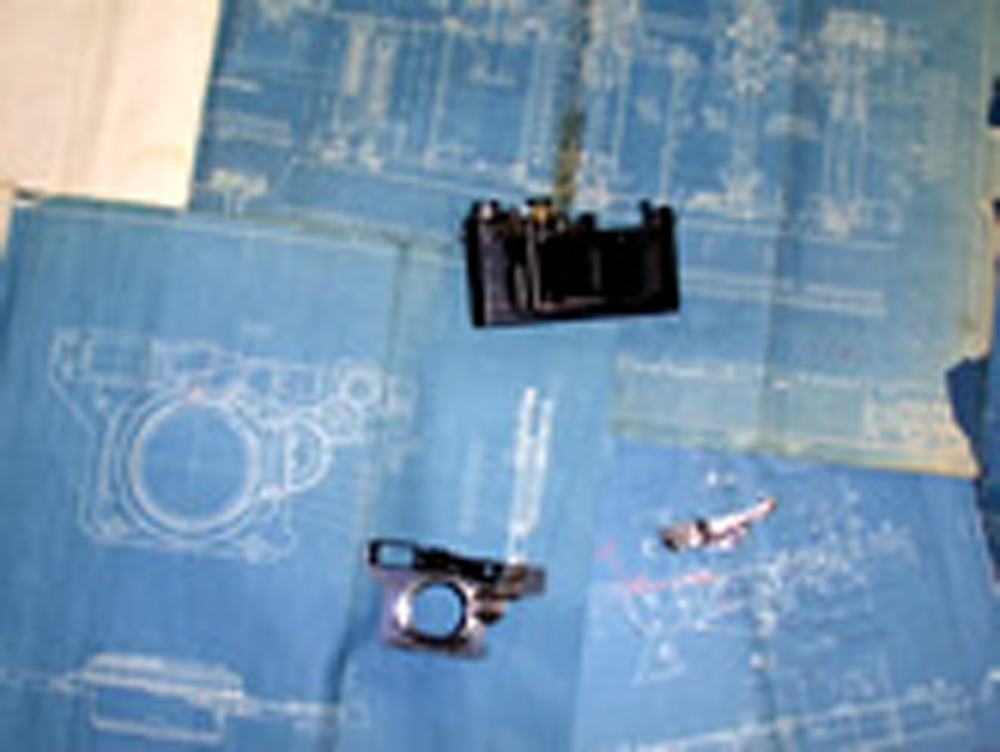
Today, drawings are based on the third-angle projection, in which an object is drawn as a top view, as it is viewed from the top. However, in the days when the original S3 was developed, the first-angle projection was used for drafting, in which an object was drawn as a bottom view by projecting the top view. Mito Nikon distributed the first-angle projection drawings to the subcontractor companies with the instructions to convert the drawings into third-angle projections for the actual manufacturing. However, the subcontractor companies did not know the differences between the first-angle projection and the third-angle projection, and manufactured the component parts by reading the drawings as drafted based on the third-angle projection.
In addition, it was found that the coating color of the finished component parts varied between lots. Component parts were subcontracted to several factories for manufacturing, and a uniformly beautiful appearance could not be attained at the final assembly if the color of the chrome coating on the outer surfaces of component parts was not uniform. Everyone involved was fully aware of the difficulty in making the coated parts look identical in color. However, no compromise was made for even slight differences in color.
Half of supplied upper covers ruined
Another problem difficult to deal with was the etching of serial numbers on the upper cover. The etching process was based on the specifications for the original S3, and the etching had to be made immediately after pressing the upper cover parts in the working procedures. This step was followed by the processes of blasting, caulking and coating, but blasting immediately after etching was extremely difficult. It was a high degree of difficulty to apply the blasting finish to press-processed brass as thin as 0.5 mm, just like paper. The similar parts for FM3A were 0.7 mm in thickness. This seemingly slight difference in thickness had such a great effect on the process that required craftsmanship. In practice, the upper covers deformed following the etching of serial numbers were rejected on the spot. This suggested that the original S3 would also have had considerably poor yield rates.
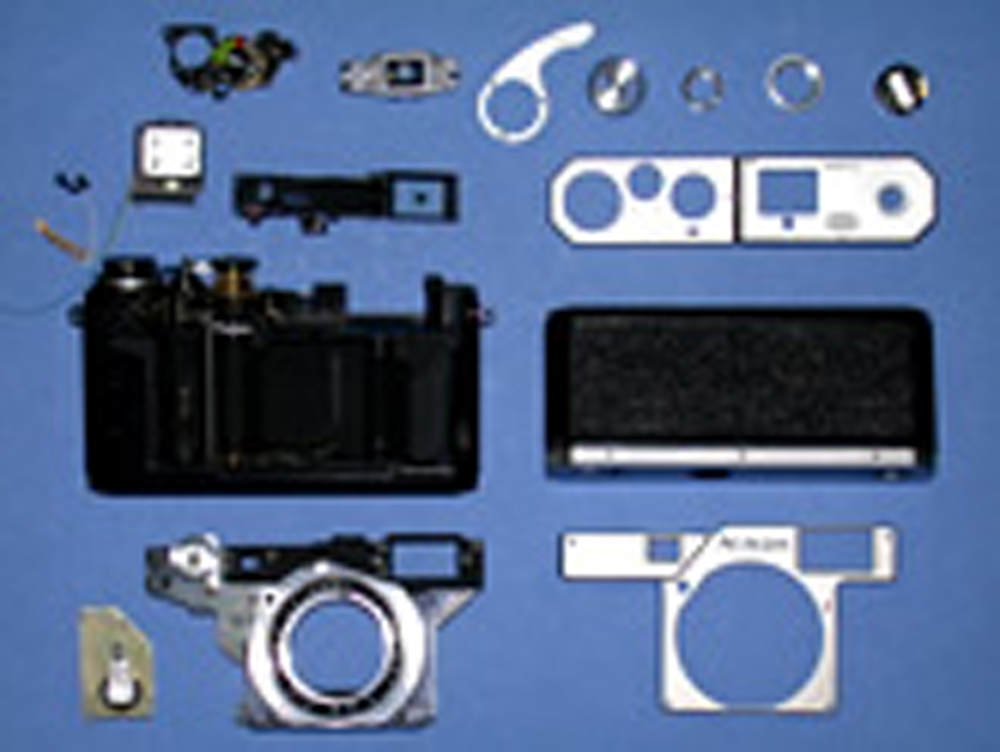
The problems encountered in obtaining the component parts greatly affected the costs, however, Mito Nikon did not allow any concessions. The S type was the basis of Nikon cameras. For the project that traced Nikon's roots, the engineers continued to work united in their efforts aimed to achieve “Faithful to the original whenever possible.”
Assembly through finished product
Elaborate assembly based on hand work at all steps

While the prospects for the procurement of component parts eventually brightened, the parts assembly had run up against a large wall. The assembling steps could not be immediately understood even by reading the old drawings. Unfortunately, there were no step-by-step procedures available. In those days, assembly was done by relying on the skills of individual engineers, including any necessary adjustments and rework. This meant that the shop floors at that time had an excellent ability to respond to changing circumstances. As opposed to the days of the original S3 in which the engineers managed to overcome any hardship at the worksites, currently manufacturing is based on the assembly of component parts in an accurate fashion according to specified steps. Mito Nikon established the proprietary working procedures for the S3 Replica model by taking advantage of the accumulated know-how about camera production and adapting it to the current manufacturing practices.
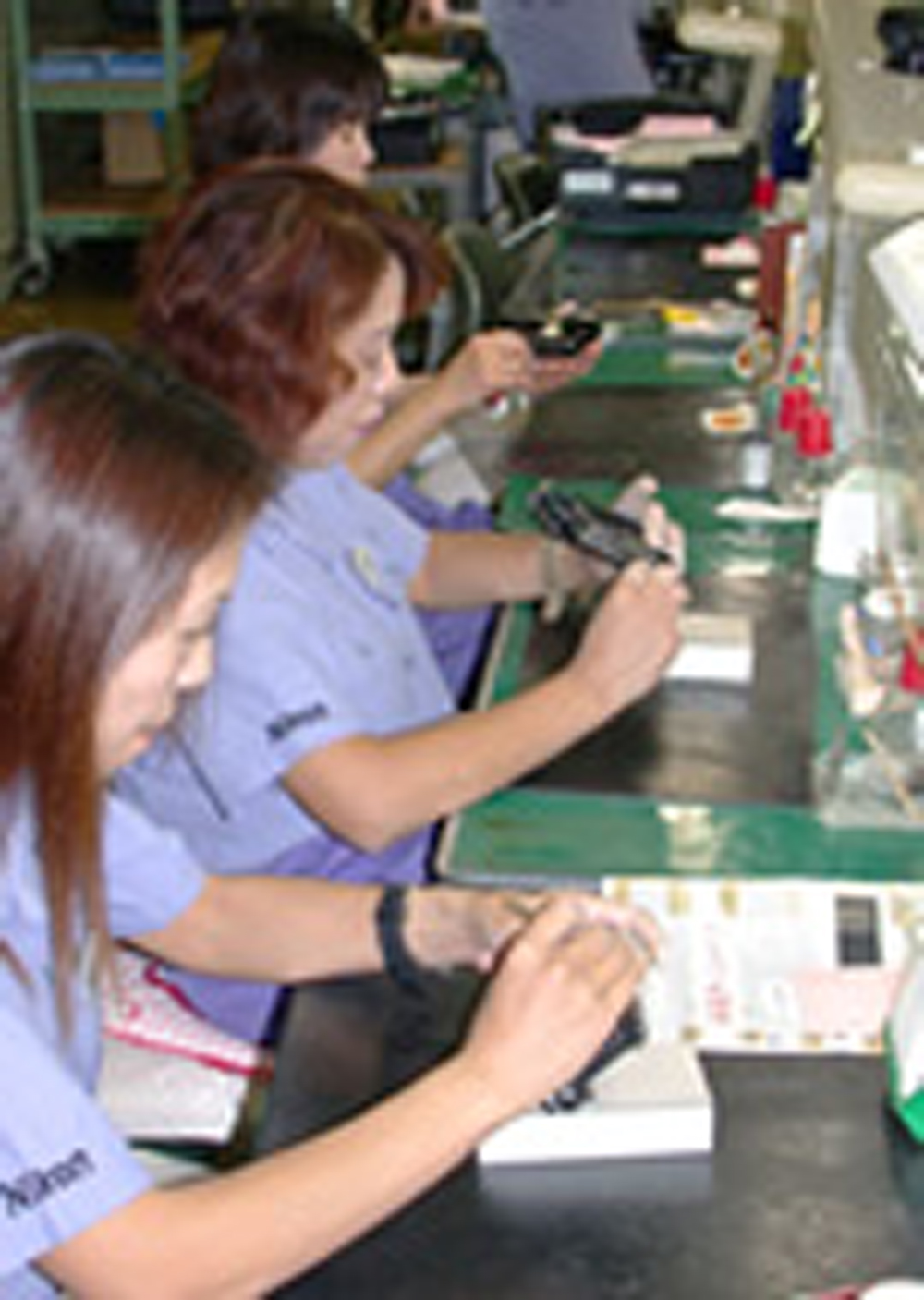
The horizontal-travel shutter called “whispering shutter” at that time was not supplied in the form of a unit, instead the shutter had to be fabricated in-house. Installation of shutter curtains also had to be done manually, but fortunately guidance on that matter was obtained from the experienced personnel remaining in Nikon. Then, after a six-month training period for assembly, the project eventually reached the stage of shipment.
Even a single finished product per day was barely available at the earlier stages
The S3 reproduction project was started with ten or so employees, after a very long behind-the-scenes period. Then, finally, the project was to enter the stage of mass production. In those days, next to the production line of the S3 Replica model installed in Mito Nikon, F3 and FM2 were manufactured in conjunction. It was a production line, but every operation had to be done manually, and it was not simple work; in addition, every employee had to be engaged in several tasks. Due to the delayed supply of component parts and other factors, the first shipment was postponed for about two months from the scheduled date; the production goal was 300 units a month by 25 employees, and finally, production reached 500 units a month by 30 employees.
According to the records in Mito Nikon, at the early stage of mass production, only one unit was reportedly finished per day. However, as the training and other various programs worked efficiently, a total of about 8,000 units were produced in the end by October 2001.

Major Specifications
Nikon S3 Year 2000 Millennium Model
| Camera type | 35 mm coupled rangefinder focal-plane shutter camera |
|---|---|
| Film format | 35 mm |
| Picture size | 24 mm x 36 mm |
| Lens mount | Nikon S mount (Bayonet mount) |
| Shutter | Horizontal-travel rubberized silk cloth focal-plane shutter |
| Shutter speeds | T, B, 1, 1/2, 1/4, 1/8, 1/15, 1/30, 1/60, 1/125, 1/250, 1/500, and 1/1000 sec. equally spaced marks |
| Focusing scales | Marked in meters (∞ to 0.9) |
| Self-timer | Variable duration type (with 3, 6, and 10 sec. marks) |
| Flash sync. contact | Variable according to time, with sync. socket, Speedlight unit synchronized at 1/60 sec. or less |
| Finder (with field frame) | Light figure type life-size viewfinder, 35 mm, 50 mm, 105 mm with light figure frame |
| Film sensitivity | Marked in ISO sensitivity |
| Film advance | One action lever, 136-degrees rotation, Available inch-by-inch film advance, Preparatory film feeding angle 15 degrees |
| Film rewind | Crank |
| Frame counter | Automatic reset and additive type |
| Camera back | Removable design (Not compatible with motor drive) |
| Body dimensions (Approx.) | 136 mm (width) × 81 mm (height) × 43 mm (depth) |
| Weight (Approx.) | 590 g (body), 765 g (with 50 mm f/1.4) |
Nikkor S 50 mm F1.4
| Lens configuration | 7 elements in 5 groups |
|---|---|
| Focal length | 50mm |
| F-number | F1.4 |
| Aperture scales | F1.4 to F16 |
| Focusing scales | None, Focusing scales on the camera to be used |
| Angle of view | 46° diagonal |
| Shortest object distance | 0.9m |
| Attachment size | 43 mm (P=0.75) |
| Hood | 43 mm, Spring-loaded type |
| Cap | 43 mm, Spring-loaded type |
| Dimensions | 51 mm (Diameter) × 49 mm (Length) |
| Weight (Approx.) | 175 g |
Differences between the S3 Year 2000 Millennium Model and the original S3
- Focusing scales:
- Unified to the unit of meters (m) from the original range ring marked in two units, m and ft
- Automated frame counter dial:
- Changed to “ 24” from “ 20”
- Film sensitivity dial:
- Changed to ISO from ASA
- Strap lugs:
- Materials were changed to stainless steel from brass, and to chrome finish from nickel-chrome finish.
- Film rewind crank:
- Slightly changed external design
- Film rewind knob:
- Slightly changed external design
- Camera back pressure plate:
- Slightly changed external design
- Accessory shoe:
- Slightly changed external design
- Shutter dial sync. indicator color:
- Slightly changed
- Body number:
- “S3” inscribed before the serial number
- Lens:
- “Nikon” and “MADE IN JAPAN” inscribed, and multi-coating on the lens surfaces
- Lens cap:
- Changed to aluminum from plastic (“Nikon” on the back surface)
- Lens hood:
- Pitch 0.75 mm, “Nikon” inscribed
Camera Chronicle
Archives of corporate history subject matter related to Nikon cameras, including rare materials, as well as product photos of cameras and lenses.
